|
Designed
for 1024x768 by
archeophotography.com
Homepage
|
|
The
sarcophagus lid of Pakal the great in Palenque
I'm glad to provide you with a rare glimpse of the
famous sarcophagus lid of Palenque. Like more and more ancient sites
all over the world the tomb and therefore the lid has very limited
access to the public. As of 2005, if you want to visit the tomb, you
have to apply for a permit months in advance as a very limited number
of permits are given out every month. If you are able to visit the tomb
and want to take photos, you better bring good equipment as the
lighting is rather dim. Update 2013: It is no longer
possible to visit or photograph the tomb or the sarcophagus lid.
Permits are no longer given out to the public. So the photos you see below are historic.
Despite many attempts to "debunk" the PaleoSeti Theory in terms of the
sarcophagus lid and attempts of archeologists to find more
down-to-earth explanations, I'm still convinced that the lid shows a
technical scene misinterpreted by the ancient Maya.
It's not just the lid that points to this, it's also the
mask of Pakal himself, which was found inside the sarcophagus, that
leads me to that conclusion. See below for more info.
Please click on a picture to
enlarge
and read the Copyright
notices, that I gathered here.
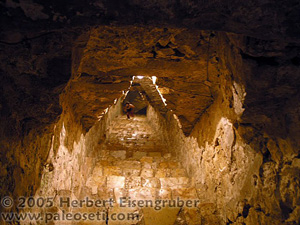 |
Once you pass the "permit hurdle" you can climb
down deep inside the interior of the pyramid. You decend a bunch of
dimly lit, narrow corridors. This is nothing for claustrophobic folks.
The heat and humidity leave no part of your body and clothes dry.
|
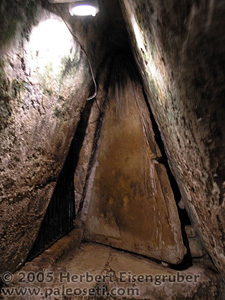 |
In order to relief the tremendous weight of the
pyramid above, the ancient architects chose the very stable triangle
form of passages and the tomb. Even the door to the tomb itself is
triangular. One can't enter the tomb itself - not even with the permit
- it's locked with bars and chicken wire like material. During my visit
there was a hole in the wire, just big enough so I could stick my
camera lens through. I'm acutally not sure if taking photos is allowed,
but the guard that accompanied me had to use the washroom, so I was
about ten minutes alone with the lid. No other tourists, just myself
and this iconic piece of archaeology. After many years of dreaming
about visiting Palenque and the lid, this was a special treat for me
that I will never forget for the rest of my life.
Update 2013: It is no longer possible to visit or photograph the tomb
or the sarcophagus lid. Permits are no longer given out to the public.
|
|
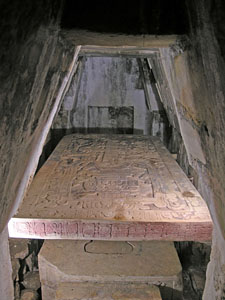
|
And here is what you will see if you get the chance
to visit. Like I said, photographs like these are rather rare.
The famous sarcophagus lid of palenque. The tomb and the lid are at the
heart of the pyramid of the inscriptions. In fact the pyramid was built
around the tomb, so moving the lid out of the tomb is impossible. If
this wouldn't be the case, Im convinced that the lid would have been
gone already.
|
Please click on an area of the lid that interests
you and you will get an enlarged view.
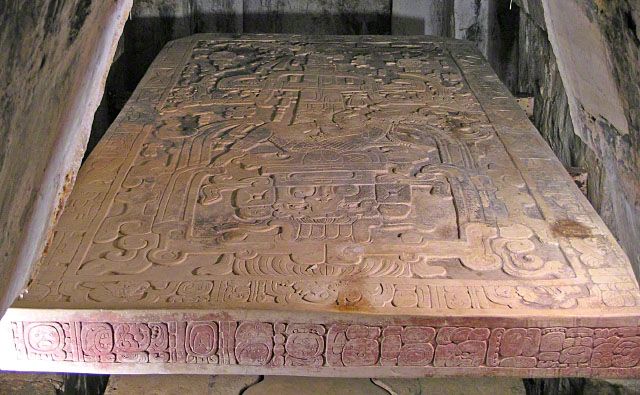
Below: An artists (unknown artist) rendition of the entire sarcophagus lid as seen from the top. 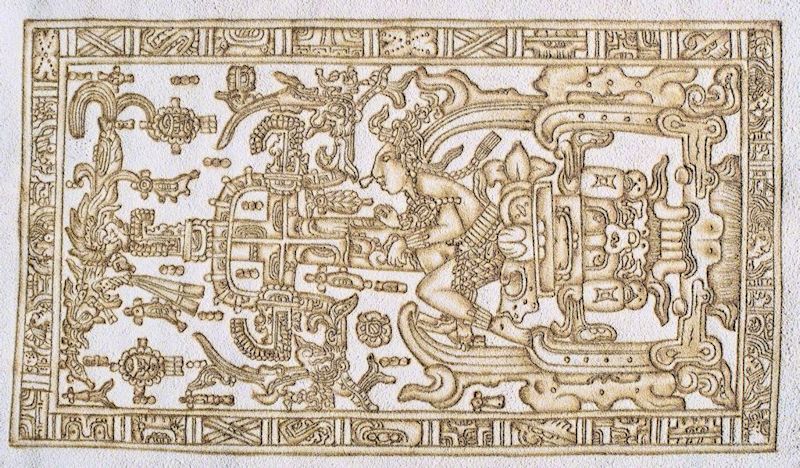
|
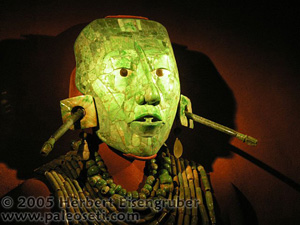
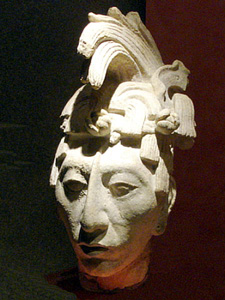
|
On the left you see the death mask of Pakal the
great, the ruler for whom the tomb was built. The mask is complete made
from Jade and is now in the Museum of Anthropology in Mexito City.
Please click on the photo and look at the face closely. When was the
last time you have seen a human being with it's nose starting that high
on the forehead? I don't think that just an artist's rendering as other
depictions of Pakal show the same facial features. (Below left, Credit:
A. Skromnitsky, Wikipedia Commons) I traveled extensively through
Mexico and I have seen the same facial features in the proud Maya
people of today except the nose that starts in the middle of the
forehead.
Was Pakal the last direct decendant of ancient astronauts? Did his
facial features indicate that?
Did the Mayans of Palenque put all their memories of their gods onto
the sarcophagus lid when the last descendent of the gods died?
|
|

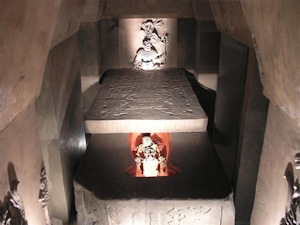
|
A word about replicas.
As I said somewhere else on this website there is a worldwide trend to
lock down OUR archaeological treasures of the past and only make them
accessable to a VERY small elite archaeologists that literally hold the
key. Everywhere in the world the argument is being made that tourists
are damaging the ancient treasures beyond repair.
While I agree that great care should be taken in preserving our
archaeological treasures and access should be controlled, it is
completely unacceptable to make them completely unaccessable to the
public.
In a discussion with an archaeologist who doesn't want to be named on
this site, she made the argument that replicas serve the same purpose
for the interested public without putting the original artifact in
danger.
Well, that sounds good in theory, but I have to ask the question why
the galleries of the world display REAL Picassos, Rembrandts and
DaVincis... The answer is simple: Because a copy or a replica is not
the real thing. Nobody would visit the Louvre in Paris, the British
Museum in London or the Metropolitan Museum of Art in New York if they
would know that all the items displayed are replicas.
Another aspect are the replicas themselves. The quality of some of the
replicas are just plain shameful. The best example for this is the
replica of tomb and sarcophagos lid of Pakal that is displayed in the
Anthropology Museum of Mexico City. Advertised as "1:1 copy of the real
thing" you can judge for yourself by the photo comparison on the left.
Top the real thing, bottom the replica. Isn't it a good replica? Really
hard to tell them apart, huh? Sorry for the sarcasm.
The solution to the problem is simple, "officials" please hear my
words:
Open the real treasures to interested people only. In order
to do that:
- Charge an entrance fee that keeps the "I-like-beer-t-shirt crowd"
out. $100 ought to do it. Use the money to:
- Pay guards well to protect the sites and educate them. This creates
meaningful jobs and is great for the local economy.
- Limit the number of visitors per day if you must, but don't take away
the chance to see a world heritage treasure.
- If there is electricity to run lights into a space, there is also
electricity for a de-humidifier if you are worried that humidity caused
by visitors damage the artifacts.
- If the artifact is so fragile that it can't be displayed, make a GOOD
replica, that is a perfect copy of the original.
The past belongs to all of us, not just a few. We all have the right to
see our human history as it REALLY was, not as you replicate it for us
out of paper mache with a meager budget.
|
|
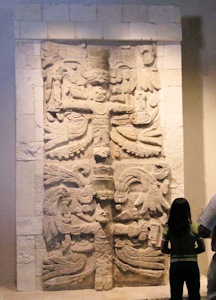
Photo 1
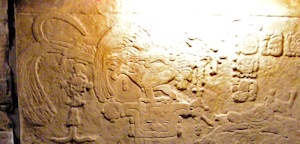
Photo 2
|
Ancient Astronaut Theorists like me always get
critizised that we only see what we want to see and rip things out of
context. We ignore other, similar finds and never talk about them. And
they claim the Sarcophagus lid of Palenque is a prime example for this.
Just by showing similar examples of items that we claim is proof of an
extraterrestrial visit in the past, critics of the PaleoSeti Theory
debunk the Theory. Case closed, let's move on.
Well, let's have a look at this and put all the cards on the table. Let
us take a look at the iconography on the lid, compare it with other
similar depictions and see if the Ancient Astronaut Theory can hold up
or if we really have to "close the case". In defence of the critics I
have to say, though, that what I'm doing here is very rare and I would
like to see this done by other Ancient Astronaut Theorists as well. The
credibility of the Theory would increase enormously.
But let's start and compare the opinions:
I had this friendly and constructive discussion with an archaeologist
friend of mine a few years ago on an archaeology forum. In my opinion
this conversation was what should happen more often between Ancient
Astronaut Theorists and "Official" Archaeology. The discussion that I
recorded is very interesting I think and it explains the official view
as well as my theory on the sarcophagus lid of Palenque. The
Archaeologists opinions are in orange,
my views are in green.
Central on the lid
is Pakal the great, ruler of Palenque. His body is depicted in a
peculiar way that we think symbolizes rebirth, but he is resting. Makes
sense as this is a tomb.
Next we see the "tree of life" growing out of Pakal's body. The tree of
life is a symbol often seen in Maya mythology.
Yes, I
know what you mean, I have seen this "tree of life" often. I
photographed it at other places in Palenque and on other sites.
[inserted photo 1 top left]
Wow,
I'm surprised! Yes, exactly what I'm talking about. Those are actually
good examples.
Next you see on top of the tree of life the Quetzal bird which had
special meaning to the Maya as it represents the sky and the heavens.
That's why it sits on top of the tree of life.
Yes, I
have also seen the Quetzal bird numerous times [inserted photo left]
Good.
Now let's see what is underneath Pakal. First we have to know that
Pakal that the whole lid depicts Pakal's decent into the underworld.
Therefore underneath Pakal we see a lot of symbolism that is connected
to the Mayan underworld. He is falling into the mouth of a monster or a
serpent. We can see the sungod, half skeletton, half flesh. Typical for
Mayan iconography. At the very end you see hairs of the doubleheaded
serpent that wraps around the whole scene. The hair are also typical
and can be seen in many other depictions. There are a few other details
on the lid. I could talk much more about, but for now I want to hear
what you have to say. But just so much. The iconography on the lid is
consistent with everything else we found in the Mayan world. Nothing on
the lid is out of the ordinary. We don't need spaceships or Aliens to
explain it. If you think different, well the burden of proof is on you.
I think our knowledge and explanation of the lid is pretty solid.
Ok, before I answer
you with the Ancient Astronaut Theory I would like to ask you some
questions.
Fire away
Is what you just
told me undisputed among archaeologists?
[laughs] Nothing is
ever undisputed among archaeologists. There are some variations of the
explanations of some symbols etc. But what I told you is the most
respected interpretation.
Do you share it 100%?
Yes,
but maybe 95%. There is always room for "adjustments"
I know you are open
minded, otherwise you wouldn't talk to me. How many books about the
ancient astronaut theory have you read?
I have to admit,
none. But I know you guys say it's a spaceship or rocket of some sort.
I know what evil things you can say to me right now and where your
question is leading to. One shouldn't talk about things we don't know.
But like I said the burden of proof is on you as you are the one with
the exotic theory.
[laugh]
That's no at all what I was getting at. I just wanted to know where I
have to start with my explanation. Can we agree that final proof will
never be achieved in archaeology, no matter what the theory is. There
could always be the next find that disproofs it all?
Yes, one could say
that. With certain things this would be very unlikely, though and I
have a feeling the lid is one of them.
Yes, back to the
lid. Have you seen another one like it in the Mayan world?
In
it's entirety, no. Pieces and parts of it many times as I explained
above. But the lid of Palenque is unique in it's completeness and
arrangement. It is really stunning.
So, am I correct in saying that the symbols of the lid are common Mayan
symbols, but the arrangements of them in it's entirety is unqiue?
Yes.
I would like you to
look at something that at first glimpse has really nothing to do with
whhat we are talking about. I promise you I have a point...

I The above photo is
called a photo mosaic. It's a collection of hundreds of photos from a
Mexico trip I did. The photos are arranged in such a way that it shows
Pakal's deathmask when you zoom out. If you would zoom in, you would
see small photos that have nothing to do with the deathmask.
Cute. Computer
trickery! And? Your Point?
I'm getting to it!
Patience, please! Now I have a different photo for you. Not Mayan, but
ancient nevertheless. I'm not sure if you are familiar with it.

Oh, another "looks
like" puzzle?
Kind of. Looks like
somebody riding a bicycle, doesn't it?
At
first glimpse, yes. But I'm sure you have to know the symbolism of the
culture in question. Looks Asian. Indonesia or Vietnam. You have to
know the meaning of the flowers etc to decipher this image and what it
means. It would also be helpful to know the mythological background etc.
It's from Indonesia
actually. But I'm sorry I tricked you a bit. I know that's not the way
to do things, but it's necessary to get my point across. And since you
put the burden of proof onto me, I guess I'm allowed. The above carving
is actually not ancient. It is from the 1920s or 30s on a realtively
new temple. It shows a new invention that the Dutch colonizers brought
with them when they arrived in Indonesia. The natives where so
fascinated by it that they carved it in the temple. Unfortunately the
carver had not the slightest clue what a bicycle was or how it worked.
All he knew is that is was beautiful. What is beautiful and round (like
the tires of the bicycle)? Flowers. And so on and so forth. In this
instance we KNOW this is a bycicle it not just looks like one.
You got me there!
But I still don't get what that has to do with the Palenque lid..
KThe above carver
from Indonesia saw something real, that he didn't understand. He tried
to depict it. But the only way he knew how is to carve thing he knew.
Symbols and things he was familiar with. Wheels became flowers, spokes
became a Mandala like object that is - I'm sure of it - seen in many
drawings of ancient Indonesia.
The Palenque lid is just like the bicycle of Indonesia. It is a
technical apparatus of some sort that the ancient Maya didn't
understand. So they used symbols and pictures they were familiar with.
The Quetzal bird is on top, because the apparatus was flying. The smoke
became hair etc. You are correct with what you are saying that the
symbols of the lid are common Maya symbols found in many other places.
It's the arrangement of those symbols that make the lid unique as you
said yourself before. The way Pakal is lying, the way the "tree of
life" grows out of his body. It's not the symbols themselves, it's
their unique arrangements.
Just like in the photo mosaic above where the individual photos are
just a collection of photos. The arrangement of them is what matters
I'm sorry, but you
can't argue like this. You are still missing the context of the ancient
Mayan believes and their context to the lid.
Yes, I can argue
like this and I just did. Right now I'm not talking about Mayan
believes, I'm talking about the lid. I'm sorry to get a little bit
agressive now, but I don't mean disrespect. But I find it always very
interesting how archaeologist "unpack" ancient believes when they need
them. While at other times when we have ancient myths like the story of
Kukulkan who came in a feathered serpent from the stars and brought
knowledge is just that. A story. Very convenient.
But I don't want to stride away from the lid. I have another question
for you. Underneath the lid there was a sarcophagus. And I think while
the sarcophagus lid got a lot of attention in the last decades, the
death mask of Pakal is just as interesting. Have you examined the mask
closer?
AI never personally handled the mask, but I have seen them up close in
Mexico City. It's a stunning piece. But I have to say I'm not happy in
which direction the discussion about the lid went. We are not done
discussing that yet. There is much more on the lid....
Yes, but for now I
would like to talk about the mask for a second, if you don't mind. When
have you ever seen a face like this?
What do you mean?
It's a typical Mayan face...
Really? I have
traveled through Mexico extensively and never came across any
individual who's nose bone starts in the middle of the forehead! You?
What
are you saying? The mask shows an extraterrestrial? Now I heard it all..
I didn't say that. I
asked you if you ever seen somebody in Mexico or any other place who's
nose bone starts in the middle of their forehead?
To me it's a
typical Mayan face. Maybe the artist took a little freedom of
expression with the nose...
C'mon! The mask of
Pakal is a masterpiece. You know that! It is exquisit. All proportions
are correct. You can't be seriously saying that the artist got his nose
wrong. Besides there are other depictions of Pakal showing the same odd
nose.
NWell, I don't know
what to tell you. To me it's a typial Mayan face. Next time I see
somebody with a nose like this I will let you know :)
Please do :) But
back to the lid. I would like to propose a thought experiment if you
don't mind.
Ok.
Those can be fun
Let's assume for a
moment - humor me - that I'm right. The sarcophagus lid of Palenque
depicts a technical machine of extraterrestrial origin. Could be a
rocket, spaceship, airplane or whatever. What is was is not important
at the moment. But it was something the gods brought with them and the
Maya didn't understand. Pakal was a direct decendent of those gods,
maybe the last one.
The Maya didn't know exactly what this machine was, they didn't
understand it. But they depicted it as good as they good. For this
depiction they used their symbology or - what is much more probable -
pieces of this machinery actually created
the symbolism of the Maya.
Man,
you have quite the fantasy!
I have quite the fantasy? Excuse me, I was not the one telling a story
about double headed serpents, that had beards and ate Pakal - who's
belly grew a tree with a bird on top - on his way to the afterlife,
guarded by a sungod, half skeletton, half flesh. Compared to your's my
story is actually "down to earth".
But let me finish my thought, please.
So we assume the lid depicts ancient extraterrestrial machinery. I
think this machine would be central in Maya religion. There wouldn't be
just one depiction of it, there would be a few. Otherwise it would be
very unusual. To make a long story short, I think I found just that.
Another depiction of Pakal's "spaceship" (or whatever it was) with
Pakal and a helper standing next to it and maintaining it. The engine
is turned off that's why there are no flames - hair of the serpent or
whatever - on the bottom of the carving. Here it is. Photographed in
the Anthropology Museum in Mexico City. The image is fainter then the
sarcophagus lid, but everything is still clearly visible..
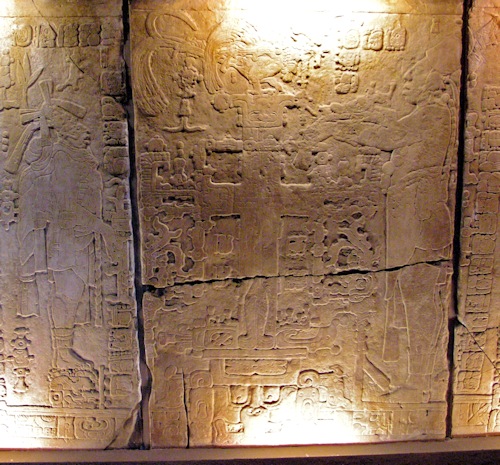
I have
to burst your bubble. The above image is again a typical Mayan scene of
the afterlife. In fact it is a great example of what I told you
earlier. You can see the same symbolism as on the lid. Thanks for the
photo actually, it is proving my point :)
Well, and I think it proves exactly the opposite. It shows that the
technology depicted on the lid was central in the Mayan religion. It's
a gigantic cargo cult that they shared with the Azteks and the Inca and
reaches back thousands of years. The technology influenced symbolism,
legends and myths. Look at the bottom of the image. Where are the beard
heair of the Sungod? Not there! Why? Because the machine is turned off.
If they are beard hairs of a god, wouldn't it be a sacrilege for the
Maya to leave them away? But please look at this picture [bottom left]:
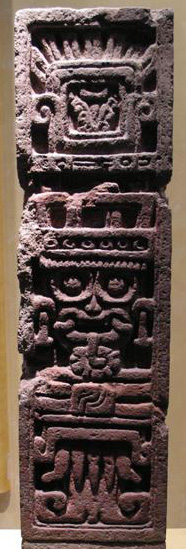 |
Again,
the beard hair of the Sungod?
Exactly.
Good example!
Well,
the beard is rather low and it doesn't really seem to be connected to
the face, wouldn't you say?
It's
an artist's rendition. There are always variations.
Ok,
so I would like you to focus on the lower part of the image. Below the
"beard".
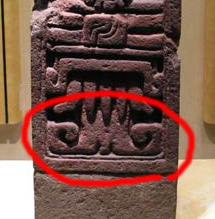
What's that?
I don't know. Looks like some ornament.
I can tell you what it is! It's the turbulence
from the exhaust hitting the ground. The Maya were such good observers,
they got it exactly right! It all makes sense!
|
[ ] .
The rest of the discussion was not about
the sarcophagus lid anymore. Other forum members chimed in and said I
had a point. From then on, everything was about me not having the
qualifications to say something like that and the experts studying for
years while I just take photos and so on and so forth. In short the
discussion went personal, like they do most of the time, unfortunately.
I'm posting this example to show that I do know the official
exaplanation of the lid and I'm NOT ignoring it. You heard the two
explanations now and you judge for yourself which makes more sense.
.
|
|
|

